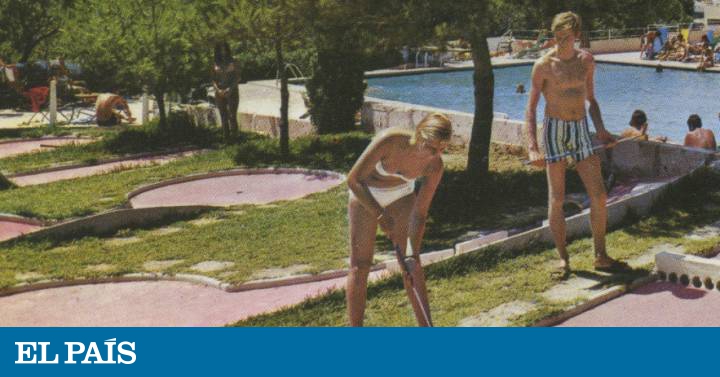Confinement and larval leisure have turned out to be the end of the world of mass tourism and the butterfly of cities and natural landscapes. The acceleration caused by the pandemic is a brilliant achievement because it has been carried out without a time machine, but at the same time it forces us to unravel the tangle of emotional threads with the world: the meaning of our actions in the environment, fear, self-pity, solidarity. Nothing will be like anything anymore and you will not have to wait for the next generations to travel futuristically. Elon Musk, the leader of Tesla, announces that in a short time his company SpaceX will offer the flights from end to end of the planet in 30 minutes at the price of a plane ticket, and high-end trips around the Earth and to future colonies in Mars. It is not a hall mirage. Covid-19 is more dangerous than the Amity Island shark in the Spielberg movie. It doesn't occur to anyone today to plan a vacation on the coast or experience the nightmare of a family cruise: if it was a disaster movie, now it seems too realistic.
We are virtual tourists, we interact through noises and sounds of takeoffs, TikTok, Zoom, and visits to the art galleries were already beginning to be anything but real. We entered the pyramids of Egypt armed with an AR (augmented reality) viewer to save us the wrath of Tutankhamun, we even adapted the visit at our whim as Canaletto did, an instagramer avant the camera that modified the Venetian reality to adapt it to the whims of the British nobles and bourgeois, who bought their vedute, an old and expensive equivalent of postcards, as souvenirs of the grand tour of the continent.
We can even make ourselves the passport of an imaginary country, in Catalonia, precisely, without the police measuring our ribs. Days ago, the consulate of Syldavia was inaugurated in Barcelona, the country that the cartoonist Hergé drew for Tintin and Snowy and where he placed the shuttle of the first rocket to the Moon (Objective: The Moon) quite a few years before Apollo 11. The Consul Honorary Enric Reverté (there are many more, in Canada, Belgium and France) received dozens of tintinophiles at his premises in the Poblenou neighborhood to deliver the sealed safe-conducts, including one who applied for political asylum. Hergé had invented his small country - which he placed in Balkan geography - in the years before World War II - appears for the first time in Ottokar's Scepter (1939) and speaks of another, Borduria, Syldavia's dictatorial enemy - , which allowed him to fantasize about an idyllic paradise free from the Hitler threat, with its own history (eight centuries), language and customs. He even introduced some tourist brochures sponsored by the Syldair airline with orientalist aesthetic photographs that serve Tintin to entertain his train journey to the Kingdom of the Black Pelican. If tourism started as a great invention, now it is a total ruin from which only North Korea, another imaginary country, is saved. Homeopathy, so denigrated by official science, has achieved its best advertising effect, a pandemic as a remedy for another pandemic.
In the last two decades, artists and curators have tackled the ugliness of humanity ridiculously crowded on the beaches and in the outskirts of the countryside (Martin Parr), analyzing tourism as an extractive industry, woodworm for museums (the Guggenheim effect), markets (La Boquería, converted into a gourmet macro-store ) and cruise terminals (Venice). They have also dealt with the overabundance of images (Thomas Struth, Tomás Pizá, Domènec), urban exploitation and migration policies (the case of Malaga in the work of Rogelio López Cuenca), the successful death of cities (Muntadas in Protocolli Veneziani , 2013) or his perversion in Apocalypse show, in enclaves such as Chernobyl, New Orleans and Fukushima (Pierre Huyghe).
In Spain, three exhibitions border the issue from an ethnological perspective. They were scheduled before the break of these months so inevitably you will have many more readings. Since Joan Miró gave his stamp to Turespaña to advertise the beaches (with a yellow, red and black sun, who knows if to marry him to the German ensign) and the motto I Need Spain (1983), not a few photographers collaborated with promotional dynamics: Pérez Siquier, Francisco Ontañón, Català-Roca or Ramón Masats, the latter is the exhibition in Tabacalera (Visit Spain. 1955-1965) on folk rites that the Franco regime presented as topics for foreign visitors.
Others were propaganda professionals, such as Josep Planas Montanyà, owner of the tourist postcard monopoly and owner of Casa Planas, founded in Mallorca in 1949. He came to have his own helicopter (which he rented from the Civil Guard!) That It was used to take aerial images of coastal exploitation, which were later used as a model in the emerging economies of Asia and Latin America. For Es Baluard, his granddaughter, the artist Marina Planas, has composed a mosaic of 600 photographs from the archive (some of an intimate or family nature, where famous figures such as Joan Fontaine, Chaplin, Fraga, Mussolini with Franco appear) with texts and images extracted Internet that illustrate the Spain of developmentalism. Finally, the IVAM contributes a documentary set put together by Alicia Fuentes, with posters, brochures, magazines and photobooks from the Spanish Levante publicized as the "periphery of pleasure", where tourists could live authentic experiences in "an Eden in southern Europe" before of becoming lysergic with the cod route. From there to the virtuality of the sofa at home, you only had to take one step.
War approaches to tourism: all inclusive . Marina Planas. It is Baluard. Palma de Mallorca. Until September 27.
On vacation in the land of the Hesperides . IVAM. Valencia. Until August 30.
Visit Spain. 1955–1965 . Ramón Masats. Tobacco. Madrid. PhotoEspaña. Until October 12.

